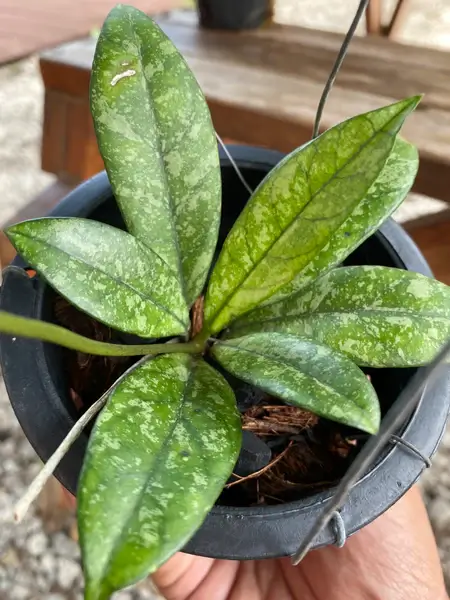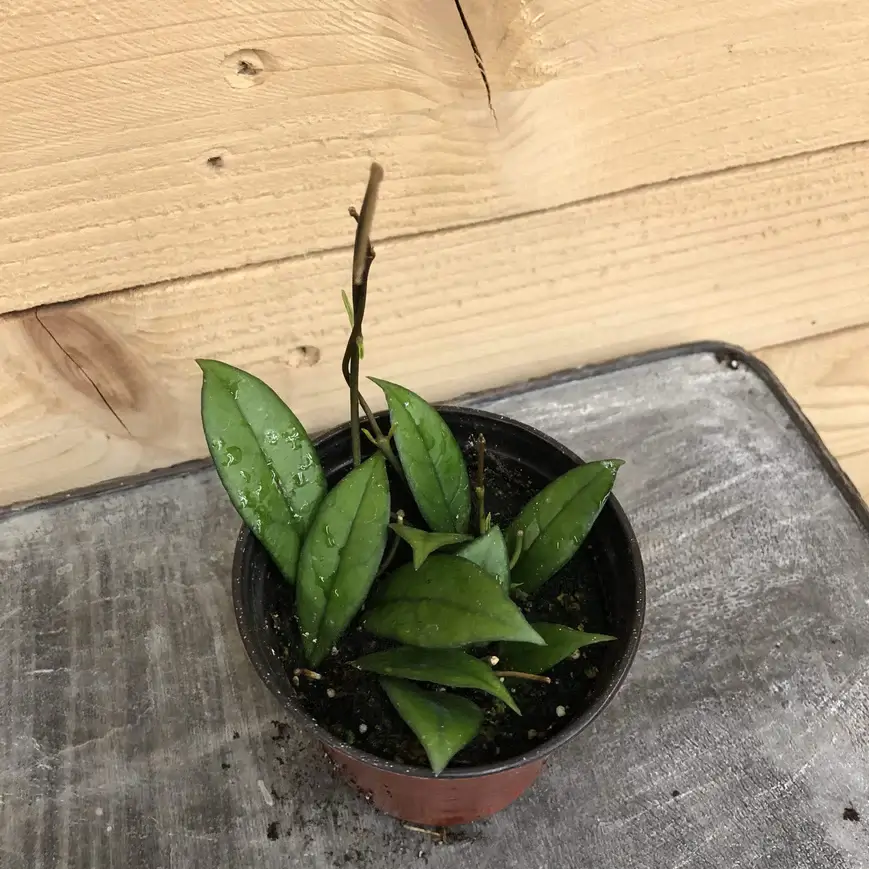One of the easiest houseplants to manage is the Hoya crassipetiolata. It is a rare plant, but a great option for those who are searching for their green thumb or great beginner plants for children’s rooms where responsibility and awareness can be taught. There are just a few things you have to do to keep it alive, but with minimal attention and a little care, you can have one thriving and growing houseplant in a short time.
In This Article
Caring for the Hoya Crassipetiolata
Keep in mind that the Hoya crassipetiolata does not need much work or attention to thrive and be cared for at home. It does have a few minimal requirements that are met easily in each household that refer to the following:
- Sunlight and placement
- Water
- Temperature
- Soil and potting preferences
1. Sunlight and Placement
If you do nothing else for the Hoya crassipetiolata, make sure that you put this plant where it can reach the sunlight at all times. It thrives on direct sunlight, and should always be either in the window or within a few feet so that it can absorb those rays each day, all day long.
If you are not sure which room to place your Hoya in, consider a southern window where the sun is coming in throughout most of the day. It will start getting sunlight very early and can continue pulling out rays even when the sun is going down later.
If you live in an area where there isn’t a lot of sunlight, you can still have this plant, you just need artificial light in your home. if you have large fluorescent lights or other types with UV rays, make sure the plant is located directly beneath them to get the most light available.
2. Water
Because it does well in dry areas, it only needs water sparingly. If it is a young plant, consider watering it once the soil dries out. On average, these plants need water once every 10 to 14 days, depending on the quality of the soil that your plant is in.
If you do over water your plant during one of the cycles, allow the soil to dry out before you water again. You do not need to leave water lingering, and it will not pull a lot of water out of the soil between purrs as long as it doesn’t move from its location.
You also do not want to forget to water it for weeks, either. While it doesn’t need a whole lot of water, there is some that is needed for it to keep its energy and continue growing beautiful, strong leaves.
3. Temperature
The Hoya crassipetiolata does very well inside normal room temperature homes around 70 to 75 degrees. If it is warmer or even a little cooler, they can withstand these temperatures also for short periods of time. It is best to keep them in an area where the temperature will not be changing too often.
If you need to sit the Hoya outside for a few days, you can do that during the warmer months. When the weather, is extremely hot or cold, you do not want to put the Hoya outside. Consider moving it to a different room that is temperature controlled if necessary.
4. Soil and Potting Preferences
When you pot your Hoya plant, make sure you put fresh soil in the pot that has nutrients available. You will not need to add additional fertilizer to the Hoya. By the time the nutrients in the soil have depleted, the plant will need to be reported, and more fresh soil applied to give it ideal growing conditions.
When you first plant the Hoya, make sure that the soil is moist to give the plant an opportunity to get the water it needs and then drain. Many of these plants do well with small rocks or pebbles in the soil so that it drains effectively after each watering.
Even if your Hoya plant reaches maturity after a few years, it is a good idea to give it a repot annually so that it can get fresh soil. You need to maintain that plant to keep it growing because it is a great way to boost the color of your home and make the area feel warm.
Background on the Hoya Crassipetiolata
When you bring this plant into your home, you may want some background, so you understand why it is thriving and how to continue that process. Keep in mind that this plant is native to dry and warm areas of Australia and Southern Asia, so living in a home with central heat and air makes for a great environment year-round.
If you are caring for a Hoya, and it starts to change color or appear as though it is dying then it is lacking something like sunlight or nutrients in the soil. This happens when Hoya plants have started to outgrow their current pot, but have not been repotted. Do not assume that the plant is going, dormant, however, since it does not have a dormant season.
This is a great video overview of a series of Hoya Plants, but particularly you can see an actual Hoya Crassipetoilata in action (the video is queued to start right at that point):
FAQs About the Hoya Crassipetiolata
If you still have more questions, so do many others who have taken over this plant or inquired about adding it to their home collection. I certainly had a few since this is a rare plant and not one that I knew very much about before adding to my own collection.
Below are some of the most common questions that are asked.
Yes! At this time, there doesn’t seem to be an issue with Hoya in homes with pets. They are living and growing in homes everywhere that have both cats and dogs roaming throughout and they are living harmoniously. Should your pet ingest any of these plants, however, it is still a good bet to give your vet a call if you notice any strange behaviors.
Since the Hoya likes to double its size each year, many of these can reach as tall as four feet before being considered mature plants. You can spread it out throughout your home because it will vine out and can be that long in several directions.
The plant itself will double its size in the first year and continue on a similar trend for several years. After about 2-3 years of quality conditions, the Hoya crassipetiolata will start to flower and grow foliage throughout the year. This is when you know it is taking away attention from the vines and putting the energy into other areas.
While this plant is pretty straightforward in growth and what it needs, it can come with a couple of common problems. The first problem you might encounter is stunted growth, where the plant isn’t growing but isn’t getting worse either.
This means that something has most likely changed with the sunlight due to weather or positioning. You may want to change the room where your plant has been staying or consider adding a UV light over it for a few days to give it some energy.
Another common problem is part some plants look really extended and there isn’t much foliage available. This happens when both the nutrients are lacking and maybe some sun. It can’t hurt to give the plant a new pot since it is most likely time for an upgrade.
Hoya Crassipetiolata Splash vs. Flower vs. Bloom vs. Variegated
One distinction you’ll frequently see with Hoya Crassipetiolata is that of splash vs. flower vs. bloom.
You can find a brief overview of each below to help understand how they’re different.
What is a Hoya Crassipetiolata Splash?
A Hoya crassipetiolata splash is a type of hoya that is known for its distinctively large and colorful leaves. The leaves are usually variegated with colors like pink, white, or yellow. The plant is native to Southeast Asia and typically blooms in the late spring or early summer.
What is a Hoya Crassipetiolata Flower?
A Hoya crassipetiolata flower is the reproductive organ of the plant. The flowers are typically small and white with a center that is yellow or green. They are borne on vines that can reach up to 6 feet in length. The blooming period for this plant typically lasts from June to August.
What is a Hoya Crassipetiolata Bloom?
A Hoya crassipetiolata bloom is the flower of the plant in full bloom. The blooms are typically large and showy, with colors that can range from white to pink. They are borne on vines that can reach up to 6 feet in length. The blooming period for this plant typically lasts from June to August.
What is a Hoya Crassipetiolata Variegated?
Are You Ready For a Hoya Crassipetiolata?
If you are looking for another easy plant to add to your houseplant collection or want a starter plant, this is a great option to have. It falls in great with already established watering cycles that you may have and is a reliable plant to give that boost of brightness in your home for several years.
Hoya Crassipetiolata for Sale: Where to Buy a Hoya Crassipetiolata?
Again these are a relatively rare plant so you may not be able to find them in a local shop. There are a number of places that stock these online, fortunately, including:
- https://spokaneplantfarm.com/products/hoya-crassipetiolata-1
- https://www.craftedidentity.com/products/hoya-crassipetiolata-splash-s
- https://tropicsathome.com/product/hoya-crassipetiolata/
- https://www.unsolicitedplanttalks.com/products/hoya-crassipetiolata-splash
(Image credits to these sites as well).
Additional Sources & Resources
- https://sites.google.com/a/bsacnj.org/bsa-cnj-orchid-hoya-and-gesneriad-show/hoya-crassipetiolata
- http://www.orchidspecies.com/hoyacrassipetiolata.htm
- http://www.kew.org/science-conservation/plants-fungi/hoya-crassipetiolata-care
- https://www.glasshouseworks.com/collections/carnivorous-plants/products/hoya-crassipetiolata-care-sheet
- http://www.llifle.com/Encyclopedia/CARNIVOROUS_PLANTS/Family/Asclepiadaceae/24775/Hoya_crassipetiolata
- https://www.missouribotanicalgarden.org/PlantFinder/ PlantFinderDetails.aspx?kempercode=a905


